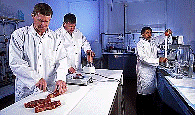United States Department of Agriculture: Agricultural Research Service, Lincoln, Nebraska

Roman L. Hruska U.S. Meat Animal Research Center: Reports
Date of this Version
1988
Document Type
Article
Abstract
The beef industry traditionally has discriminated against young heifers in the marketplace when compared with steers. Price discrimination was probably the result of sex effects on fat partitioning and distribution. Also, steers have been observed to be more efficient than heifers in the conversion of feed to carcass weight.
Both testes and ovaries secrete steroids that influence performance traits of cattle. Testosterone appears to stimulate rate of gain and efficiency of feed conversion in the male. Efficiencies of conversion of feed to live animal weight gains have been less in spayed feedlot heifers than in intact heifers.
It has been suggested that androgens and estrogens are both necessary to realize maximum growth potential. In cattle, the concentration of steroids in blood that results in the fastest growth rates corresponds approximately to a combination of the androgen level in growing bulls and the estrogen level in young heifers. Thus, the optimal treatment should maintain this natural hormone status for as long as possible, preferably several months. If the hypothesis is valid, the greatest benefits would be seen in bulls treated with estrogens, steers treated with an androgen combined with an estrogen, and heifers and cows treated with androgens.
Therefore, the objectives of the investigation were to determine the effects of surgical castration, estradiol immunoneutralization and(or) treatment with an exogenous androgen (trenbolone acetate) on growth, carcass characteristics, and meat palatability of heifers fed in a feedlot.


Comments
Published in Beef Research Program Progress Report (1988) No. 3: 41-42